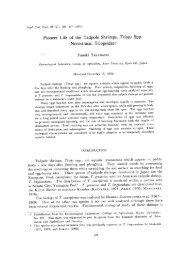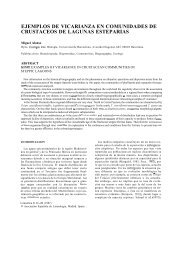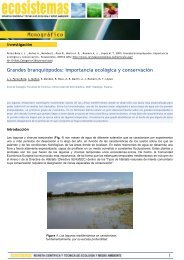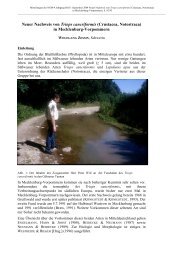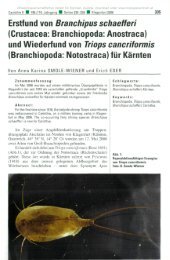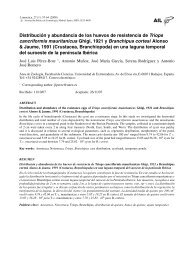Reproductive isolation and genetic differentiation in North American ...
Reproductive isolation and genetic differentiation in North American ...
Reproductive isolation and genetic differentiation in North American ...
Create successful ePaper yourself
Turn your PDF publications into a flip-book with our unique Google optimized e-Paper software.
126<br />
<strong>American</strong> populations alone prompted the description<br />
of five additional species (as Apus) over the last century<br />
(Packard, 1871; Rosenberg, 1947). Packard’s three<br />
species (T. lucasanus, T. newberryi, <strong>and</strong>T. aequalis)<br />
were based on a very limited number of specimens<br />
from a small number of localities <strong>and</strong> Rosenberg’s<br />
two species (T. oryzaphagus <strong>and</strong> T. biggsi) were based<br />
on specimens from unisexual populations collected<br />
from California rice fields. L<strong>in</strong>der (1952) surveyed<br />
a large number of museum lots, primarily from the<br />
US National Museum, <strong>and</strong> reanalyzed many of the<br />
characters used by Packard <strong>in</strong> describ<strong>in</strong>g <strong>North</strong> <strong>American</strong><br />
forms (Packard, 1871; 1883). L<strong>in</strong>der documented<br />
a wide range of variability <strong>in</strong> many morphological<br />
characters <strong>and</strong> <strong>in</strong> sex ratio <strong>and</strong> viewed <strong>North</strong> <strong>American</strong>Triops<br />
as a polytypic species with many locally<br />
differentiated sexual populations as well as other, even<br />
more derived, partheno<strong>genetic</strong> forms. Accord<strong>in</strong>gly, he<br />
reduced Packard’s <strong>and</strong> Rosenberg’s species to junior<br />
synonyms of T. longicaudatus. He also extended the<br />
range of this species to <strong>in</strong>clude populations from the<br />
Galapagos Isl<strong>and</strong>s, the Hawaiian Isl<strong>and</strong>s, <strong>and</strong> Argent<strong>in</strong>a.<br />
Longhurst (1955a) concurred with L<strong>in</strong>der (1952)<br />
on the synonymy of the <strong>North</strong> <strong>American</strong> populations<br />
<strong>and</strong> added to this synonymy all the species of Triops<br />
that had been described from the West Indies <strong>and</strong> South<br />
America. He also extended the range to <strong>in</strong>clude New<br />
Caledonia <strong>and</strong> Japan.<br />
The exist<strong>in</strong>g morphological data strongly suggest<br />
substantial amounts of <strong>genetic</strong> variation with<strong>in</strong> Triops<br />
longicaudatus. Bisexual populations vary considerably<br />
<strong>in</strong> characters such as the number of body r<strong>in</strong>gs, the<br />
number of term<strong>in</strong>al body r<strong>in</strong>gs which lack appendages,<br />
<strong>and</strong> patterns of sp<strong>in</strong>ation of the telson. Furthermore,<br />
unisexual forms often differ from bisexual populations,<br />
<strong>and</strong> exhibit reduced variability of these traits. To date,<br />
there has been no analysis of <strong>genetic</strong> <strong>differentiation</strong><br />
<strong>in</strong> <strong>North</strong> <strong>American</strong> Triops nor is there any <strong>in</strong>formation<br />
about the relatedness of bisexual <strong>and</strong> unisexual<br />
populations. We report here the results of studies on<br />
allozyme <strong>differentiation</strong>, population sex ratio, reproductive<br />
biology, <strong>and</strong> morphological variability <strong>in</strong> a<br />
series of populations distributed over much of western<br />
<strong>North</strong> America. Our results <strong>in</strong>dicate that the polytypic<br />
T. longicaudatus def<strong>in</strong>ed by L<strong>in</strong>der (1952) <strong>and</strong><br />
Longhurst (1955a) is actually a mosaic of several biologically<br />
different k<strong>in</strong>ds of populations, represent<strong>in</strong>g<br />
at least two dist<strong>in</strong>ct species, that occasionally coexist<br />
without <strong>in</strong>trogression.<br />
Materials <strong>and</strong> general methods<br />
Populations sampled<br />
We have sampled 44 populations of Triops from<br />
throughout the western United States over the last sixteen<br />
years. The geographic distribution of sampl<strong>in</strong>g<br />
sites is shown <strong>in</strong> Figure 1 <strong>and</strong> collection details are<br />
given <strong>in</strong> Appendix 1. We collected morphological <strong>and</strong><br />
<strong>genetic</strong> <strong>in</strong>formation from many of these populations;<br />
however, <strong>in</strong> some <strong>in</strong>stances only distributional data<br />
were recorded. Most populations were sampled by<br />
collect<strong>in</strong>g dry soil which conta<strong>in</strong>ed desiccated cysts<br />
<strong>and</strong> subsequently rear<strong>in</strong>g <strong>in</strong>dividuals <strong>in</strong> the laboratory.<br />
In those cases where ponds were full at the time<br />
they were visited, live Triops were sampled by dip<br />
net. Those <strong>in</strong>dividuals that were collected for <strong>genetic</strong><br />
analysis were frozen on dry ice, <strong>and</strong> returned to the<br />
laboratory where they were stored at 70 C. Other<br />
<strong>in</strong>dividuals were studied alive or were preserved for<br />
morphological analysis.<br />
Laboratory Rear<strong>in</strong>g<br />
Samples of 100–200 ml of soil from field collections<br />
were hydrated <strong>in</strong> 38 l aquaria of dem<strong>in</strong>eralized water<br />
provided with aeration <strong>and</strong> fluorescent illum<strong>in</strong>ation at<br />
ambient temperatures(20–25 C). Hatchl<strong>in</strong>gs were <strong>in</strong>itially<br />
fed with pulverized fish food pellets. As the<br />
animals grew they were fed freshly killed, <strong>and</strong> later<br />
live, Artemia. Upon maturity, <strong>in</strong>dividuals <strong>in</strong>tended for<br />
<strong>genetic</strong> analysis were scored for a variety of morphological<br />
characters <strong>and</strong> then frozen <strong>and</strong> stored at 70 C.<br />
Some <strong>in</strong>dividuals were reared from hatch<strong>in</strong>g to maturity<br />
entirely <strong>in</strong> <strong>isolation</strong>. From these we collected eggs<br />
that were air-dried <strong>and</strong> subsequently tested for viability.<br />
Morphological characters<br />
Individuals that were reared <strong>in</strong> the laboratory were typically<br />
scored for the follow<strong>in</strong>g characteristics: (1) sex<br />
(determ<strong>in</strong>ed primarily by the presence or absence of<br />
an egg sac on the eleventh thoracic appendage), (2)<br />
carapace length (measured from the anterior marg<strong>in</strong> to<br />
the mid-dorsal term<strong>in</strong>us), (3) total body length (anterior<br />
marg<strong>in</strong> of carapace to posterior marg<strong>in</strong> of telson,<br />
not <strong>in</strong>clud<strong>in</strong>g the caudal furci), (4) total number of<br />
body r<strong>in</strong>gs, (5) number of term<strong>in</strong>al body r<strong>in</strong>gs lack<strong>in</strong>g<br />
appendages (legless r<strong>in</strong>gs), <strong>and</strong> (6) the number of<br />
sp<strong>in</strong>es <strong>in</strong> the central row on the dorsal surface of the



